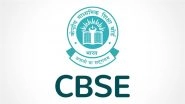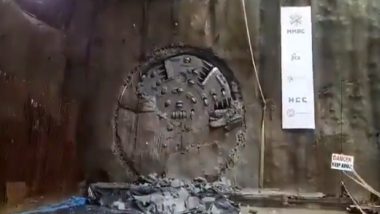Mumbai, August 2: In a major milestone, the Hindustan Construction Company has successfully completed 3.82km of underground tunneling between the Chhatrapati Shivaji Maharaj Terminus (CSMT) and Mumbai Central stations, as part of the ongoing Mumbai Metro III project.
The tunnel operation began on December 4, 2017, and has accomplished its preliminary target within a span of 20 months. The process involved an average tunneling of 190 metres per month. The precarious activity was carried out at an average depth of 20 metre below the ground, using 2720 rings. 297 Trees to be Cut For Mumbai Metro 2B Line Along 4.4-km-long Road
This section is part of the 33.50 km long Metro III line connecting Colaba-Bandra-SEEPZ (Andheri East) and will be the first fully underground metro in the city. It is being built at a cost of around Rs 23,136 crore, with a Rs 13,325 crore loan from the Japan International Cooperation Agency (JICA).
Update on Mumbai Metro III:
Commissioned on 4 Dec 17 TBM Vaitarna-1 has accomplished its target in a span of 20 months tunneling at an avg of 190m/month at an avg depth of 20m below ground level using 2720 rings. #Metro3 #MumbaiUnderground @Dev_Fadnavis @CMOMaharashtra @AshwiniBhide @MahaDGIPR pic.twitter.com/SrxS6U6XmI
— MumbaiMetro3 (@MumbaiMetro3) August 2, 2019
The HCC teams encountered several geological and urban challenges, including proximity to the Arabian Sea, tunneling through heterogeneous reclaimed land, congested working areas and drilling below some of the oldest residential and other buildings, many over a century old, without disturbing their foundations.
The Mumbai Metro Rail Corporation Ltd (MMRCL) had awarded the contract to HCC in July 2016 for the design and construction of twin tunnels by Tunnel Boring Machines (TBM) and construction of four underground metro stations at CSMT, Kalbadevi, Girgaon and Grant Road.
For the work, HCC procured two TBMs from China with 117 metre long single-shield dual-mode hard rock with a 6.68 metre diameter and weighing 848 tonnes, the company said.
These TBMs are equipped to operate in both - open or closed - modes, in the predominantly fresh, and slightly to moderately weathered Basalt and Breccia that was anticipated in the Mumbai Metro projects.
After months of geotechnical investigations, planning and procurement processes, the first TBM, Vaitarna I, was launched at CSMT on December 4, 2017. Its initial drive was completed on January 11, 2018, while the main drive ended in mid-February 2018 with a team of 32 people working on it, the spokesperson said.
Since congested residential areas are located above the tunnel, structural surveys using sophisticated instruments were carried out prior to starting the boring work in a 30 metre influence zone on either side of the alignment to assess its impact on the buildings.
With the tunneling work completed well within the stipulated time, the HCC has now taken up the work of constructing the underground metro stations, each with a unique design.
(With IANS inputs)
(The above story first appeared on LatestLY on Aug 02, 2019 06:12 PM IST. For more news and updates on politics, world, sports, entertainment and lifestyle, log on to our website latestly.com).













 Quickly
Quickly


